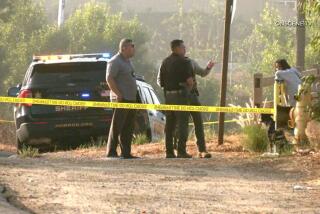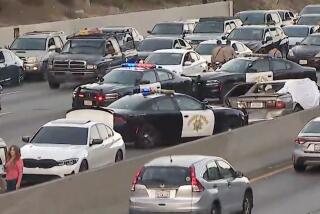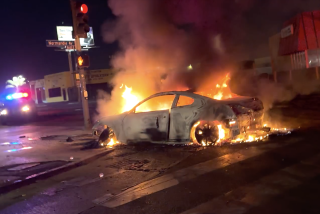Barricade to Be Re-Evaluated After Slaying : Van Nuys: The Blythe Street roadblock where a teen-ager was shot to death originally deterred crime, police say. But gangs are finding ways of using the dead-end to their advantage.
Los Angeles police said Monday that they will re-evaluate the usefulness of a street barrier in Van Nuys intended to thwart drive-up drug sales, because a youth was fatally shot in a car there last weekend after being trapped on the dead-end street by gang members.
Capt. Sidney K. Mills, commander of the Van Nuys Division, said he will discuss the 3-year-old concrete barrier with patrol and anti-gang officers this week to determine if it should stay across Blythe Street at Willis Avenue.
“If the bottom line is that I think it will be advantageous to remove the barrier, I’ll do it,” Mills said. “I will re-evaluate it this week.”
Mills was quick to say the barrier had succeeded in reducing gang- and drug-related crime on Blythe between Willis and Van Nuys Boulevard.
The roadblock, along with a ban on curbside parking, was put in place in 1987 to curtail drive-by shootings and drug dealing. At the time, the street had the grim distinction of being a drive-through drug market that drew customers from throughout the San Fernando Valley.
Police also fought problems on Blythe by concentrating an anti-drug task force in the area for nearly 18 months. The task force disbanded in May, 1989, after making more than 500 arrests, but the parking restrictions and the barricade remained in place.
Since then, police and some residents have reported that gang and drug problems have steadily increased. Some officers say that the gang members use the barricade to their advantage to trap victims and that they have learned the barrier also restricts police access to a single street, where lookouts can be posted.
“The gang members are utilizing the barricades. They have turned it around on us,” said Detective James Vojtecky, head of the Van Nuys homicide squad.
Recently, police have sent more anti-gang patrols and assigned a roving “special problems team” to Blythe Street. Mills said he was already studying new ways to attack problems there when the fatal shooting occurred Saturday.
The victim was a 16-year-old Bell Gardens youth who was in a car with three friends. Vojtecky said the four had gotten off the Ventura Freeway and became lost trying to reach Burbank about 11:30 p.m.
While driving north on Van Nuys Boulevard, they thought they saw a freeway overpass ahead but realized when they reached it that it was a railroad over-crossing. Vojtecky said the youths decided to turn west toward the San Diego Freeway and took a left at the next traffic signal--Blythe Street.
The driver apparently did not see signs at the intersection warning that warn that Blythe is not a through street. When they reached the barrier at Willis, they turned around and headed back to Van Nuys but found several young men forming a human barricade in their path.
The driver refused to stop, forcing the men to scatter. After the car passed, at least two shots were fired at the car. The Bell Gardens boy, sitting in the rear seat, was struck in the back and fatally wounded. No arrests have been made, and police asked that the names of the victim and his three friends not be revealed as a safety precaution.
Vojtecky said the slaying was the fourth in the area this year but the first involving “innocents who went in there not knowing there was a barricade.” The other slayings involved gang or drug disputes, he said.
A fifth death in the area--classified as a traffic accident--involved two women who drove onto Blythe to buy marijuana, Vojtecky said. After making a small purchase, the women turned their car around but were faced by several gang members on the street who harassed them and offered them drugs in exchange for sex.
“The driver got scared, accelerated and lost control of the car,” Vojtecky said. “She crashed into a tree, and the passenger was killed.”
More to Read
Sign up for Essential California
The most important California stories and recommendations in your inbox every morning.
You may occasionally receive promotional content from the Los Angeles Times.










